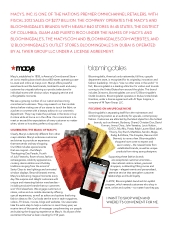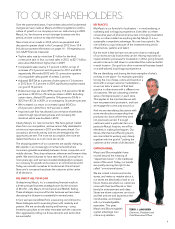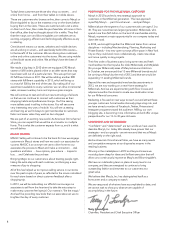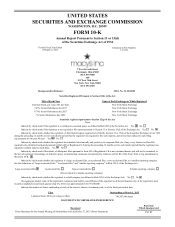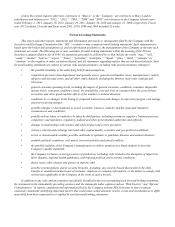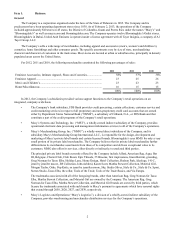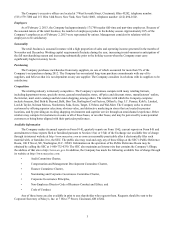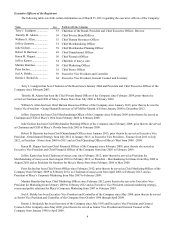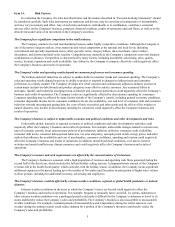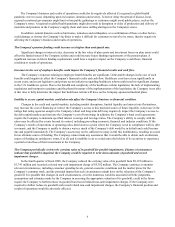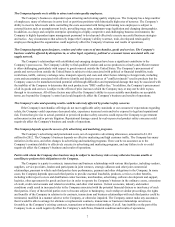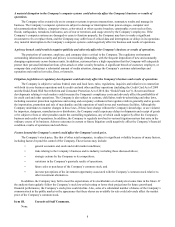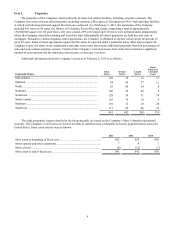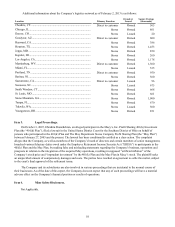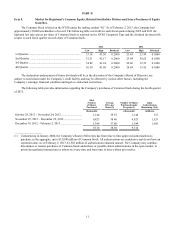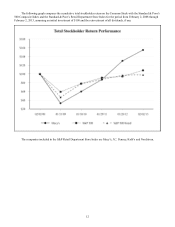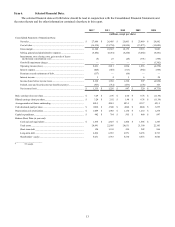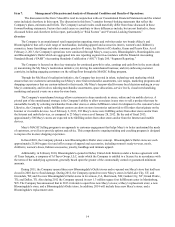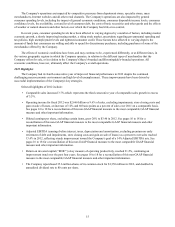Macy's 2012 Annual Report Download - page 10
Download and view the complete annual report
Please find page 10 of the 2012 Macy's annual report below. You can navigate through the pages in the report by either clicking on the pages listed below, or by using the keyword search tool below to find specific information within the annual report.5
Item 1A. Risk Factors.
In evaluating the Company, the risks described below and the matters described in “Forward-Looking Statements” should
be considered carefully. Such risks and matters are numerous and diverse, may be experienced continuously or intermittently,
and may vary in intensity and effect. Any of such risks and matters, individually or in combination, could have a material
adverse effect on the Company's business, prospects, financial condition, results of operations and cash flows, as well as on the
attractiveness and value of an investment in the Company's securities.
The Company faces significant competition in the retail industry.
The Company conducts its retail merchandising business under highly competitive conditions. Although the Company is
one of the nation’s largest retailers, it has numerous and varied competitors at the national and local levels, including
conventional and specialty department stores, other specialty stores, category killers, mass merchants, value retailers,
discounters, and Internet and mail-order retailers. Competition may intensify as the Company’s competitors enter into business
combinations or alliances. Competition is characterized by many factors, including assortment, advertising, price, quality,
service, location, reputation and credit availability. Any failure by the Company to compete effectively could negatively affect
the Company's business and results of operations.
The Company’s sales and operating results depend on consumer preferences and consumer spending.
The fashion and retail industries are subject to sudden shifts in consumer trends and consumer spending. The Company’s
sales and operating results depend in part on its ability to predict or respond to changes in fashion trends and consumer
preferences in a timely manner. The Company develops new retail concepts and continuously adjusts its industry position in
certain major and private-label brands and product categories in an effort to satisfy customers. Any sustained failure to
anticipate, identify and respond to emerging trends in lifestyle and consumer preferences could negatively affect the Company’s
business and results of operations. The Company’s sales are significantly affected by discretionary spending by consumers.
Consumer spending may be affected by many factors outside of the Company’s control, including general economic conditions,
consumer disposable income levels, consumer confidence levels, the availability, cost and level of consumer debt and consumer
behaviors towards incurring and paying debt, the costs of basic necessities and other goods and the effects of the weather or
natural disasters. Any decline in discretionary spending by consumers could negatively affect the Company's business and
results of operations.
The Company’s business is subject to unfavorable economic and political conditions and other developments and risks.
Unfavorable global, domestic or regional economic or political conditions and other developments and risks could
negatively affect the Company’s business and results of operations. For example, unfavorable changes related to interest rates,
rates of economic growth, fiscal and monetary policies of governments, inflation, deflation, consumer credit availability,
consumer debt levels, consumer debt payment behaviors, tax rates and policy, unemployment trends, energy prices, and other
matters that influence the availability and cost of merchandise, consumer confidence, spending and tourism could negatively
affect the Company’s business and results of operations. In addition, unstable political conditions, civil unrest, terrorist
activities and armed conflicts may disrupt commerce and could negatively affect the Company’s business and results of
operations.
The Company’s revenues and cash requirements are affected by the seasonal nature of its business.
The Company’s business is seasonal, with a high proportion of revenues and operating cash flows generated during the
second half of the fiscal year, which includes the fall and holiday selling seasons. A disproportionate amount of the Company's
revenues fall in the fourth fiscal quarter, which coincides with the holiday season. In addition, the Company incurs significant
additional expenses in the period leading up to the months of November and December in anticipation of higher sales volume
in those periods, including for additional inventory, advertising and employees.
The Company’s business could be affected by extreme weather conditions, regional or global health pandemics or natural
disasters.
Extreme weather conditions in the areas in which the Company’s stores are located could negatively affect the
Company’s business and results of operations. For example, frequent or unusually heavy snowfall, ice storms, rainstorms or
other extreme weather conditions over a prolonged period could make it difficult for the Company’s customers to travel to its
stores and thereby reduce the Company’s sales and profitability. The Company’s business is also susceptible to unseasonable
weather conditions. For example, extended periods of unseasonably warm temperatures during the winter season or cool
weather during the summer season could reduce demand for a portion of the Company’s inventory and thereby reduce the
Company's sales and profitability.


